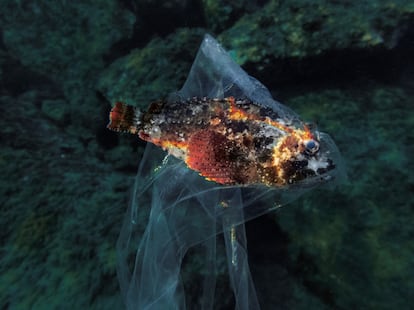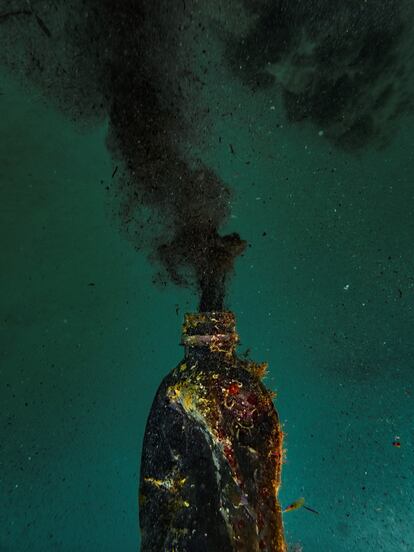Objective: Putting a stop to plastic
By the end of 2024, the planet should have the first treaty to combat pollution from this material, which each year accounts for more than 20 million tons dumped into nature. But the big producers are not going to make it easy

The pollution of terrestrial and aquatic systems by the plastics that humans consume and whose waste we do not manage well, is one of those environmental problems that we already measure in millions of tons: every year, more than 20 million tons of plastic (the equivalent of 1,770 truckloads every day) are dumped into nature. The scenarios proposed for the coming decades point to a considerable increase in these discharges into the environment if the problem is not solved. And to address it, more and more experts are only considering one solution: stopping the production of plastic, a derivative of petroleum, which is itself one of the fossil fuels responsible for the climate crisis.
It is not enough for a country to act on its own and impose vetoes; coordinated action is needed on an issue that, as with most environmental problems, transcends borders. Because just as waste travels from one nation to another (normally, from a rich one to a poor one) to be supposedly managed although it often ends up tossed into nature, plastic travels through rivers to contaminate the oceans—and even the air — crossing countries and continents.
Climate change has had a framework convention created within the UN since 1992 to address the great global crisis caused by global warming. From it, there emerged in 2015 the Paris Agreement, which governs all efforts to eradicate greenhouse gas emissions that have led the Earth to the current exceptional situation.
In that sense, 2024 should be the equivalent of 2015, but focused on plastic pollution. The countries represented in the UN decided that by the end of this year the world should have the first treaty to stop this kind of pollution.

The complex process to prepare this international agreement began in 2022 and has continued at a good pace until late 2023. But the last meeting held in Nairobi last November awakened many from the dream of reaching a quick agreement. Because, as diplomatic sources monitoring the process explain, the nations most reluctant to fully address the problem and with more vested interests (led by oil producers) are slowing down the negotiations. In that sense, it now seems more complicated to have the treaty approved by the end of 2024. In addition, fears are growing that some of the mistakes made with the Paris Agreement in 2015 will be repeated.
Let’s go back to the data. Plastic pollution is already measured in hundreds of millions of tons, but to find the origins you don’t have to go back thousands of years, just a handful of decades. In 1950, global plastic production was barely two million tons. Three decades later, in 1980, it had multiplied almost 40-fold, reaching 75 million tons. Currently, more than 460 million tons are produced each year. And the vast majority – around 95% – is primary plastic, that is, only 5% comes from recycling. This is due to how easy and cheap it is to manufacture it, among other things, because the costs that its production and disposal cause to society are not well reflected in its price. In short, we live in the generation of disposable plastic.
All of this data comes from different reports prepared by the OECD (Organization for Economic Cooperation and Development), whose experts warn of a negative scenario if policies do not change: in 2040, global plastic production will reach 765 million tons, of which only 9.5% will be recycled. In 2060 it will reach over 1.2 billion tons, and only 11.6% will come from secondary recycling.
To better understand the matter, it is good to know what we use plastic for. Its first destination is (up to 30%) containers and packaging. That is, products with a very short life. Construction, vehicles and clothing follow at a distance. The second key is to know where these plastics end up after their use: according to the latest data from the OECD, of the 360 million tons of plastic waste generated in 2020, only 9.4% was recycled. Another 18.6% was incinerated and 50% ended up in landfills. And 22.5%, that is, 81 million tons, was not well managed and ended up polluting the environment.

It is estimated that more than 20 million tons of plastics are dumped uncontrollably every year. 30% ends up in rivers and seas and the remaining 70% on land. By 2040, the horizon for the objectives and commitments of the plastics treaty, according to OECD experts, is that discharges will grow by 50%, reaching almost 30 million tons annually. The problem is the same again: the absence of reuse. For the same year 2040, the OECD estimates that, if current policies do not change, only 14.2% of plastic waste will be recycled, slightly more than the current 9.4%. We are not learning the lesson.
For this reason, the European Union, a good number of Latin American and African nations, and other countries insist that the future treaty being negotiated at the UN should really cover the entire life cycle of plastics, which would lead to creating limits on the production of the original product. But another set of nations are now trying to ensure that this pact only considers measures involving pollution, that is, once the problem has occurred and not to its source. In that group are, according to diplomatic sources, nations such as Saudi Arabia, China, Russia, Iran and Egypt.
To some extent it is similar to what happened with the Paris Agreement, whose objectives allude to greenhouse gases, but which does not directly address the reduction of oil, gas and coal production, that is, fossil fuels, which are mainly responsible for these emissions. [The recently ended COP28 summit in Dubai for the first time talks about “transitioning away” from fossil fuels].
The Paris Agreement also establishes a common objective and then the countries present climate plans in which each one decides its own emissions reduction goal. This model is the one that the less ambitious countries (and the United States) also contemplate for this hypothetical plastic pact. The most committed nations, however, want the treaty to include specific measures against certain plastics and chemicals, which are binding on all its signatories.
One of the greatest difficulties lies in the rules of procedure, that is, in how these types of disputes are resolved between negotiators. Initially, it was proposed that this plastics treaty should be open to the possibility that a vote could be taken to break blockade situations, and that a proposal could be put forward with two-thirds of the countries’ votes. But less ambitious states now want the same Paris formula: all decisions must be made by consensus, which can lead to a minority blocking any progress and the global ambition of a pact that should put a stop to plastic pollution in 2024.
Sign up for our weekly newsletter to get more English-language news coverage from EL PAÍS USA Edition
Tu suscripción se está usando en otro dispositivo
¿Quieres añadir otro usuario a tu suscripción?
Si continúas leyendo en este dispositivo, no se podrá leer en el otro.
FlechaTu suscripción se está usando en otro dispositivo y solo puedes acceder a EL PAÍS desde un dispositivo a la vez.
Si quieres compartir tu cuenta, cambia tu suscripción a la modalidad Premium, así podrás añadir otro usuario. Cada uno accederá con su propia cuenta de email, lo que os permitirá personalizar vuestra experiencia en EL PAÍS.
¿Tienes una suscripción de empresa? Accede aquí para contratar más cuentas.
En el caso de no saber quién está usando tu cuenta, te recomendamos cambiar tu contraseña aquí.
Si decides continuar compartiendo tu cuenta, este mensaje se mostrará en tu dispositivo y en el de la otra persona que está usando tu cuenta de forma indefinida, afectando a tu experiencia de lectura. Puedes consultar aquí los términos y condiciones de la suscripción digital.










































